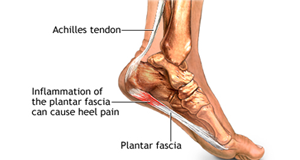Plantar Fascitis
Fasciitis of the sole of the foot called plantar fascitis
Plantar fascitis is one of the most common conditions causing heel pain. It involves inflammation of the plantar fascia — a tough, fibrous band of tissue that runs along the sole of the foot. The plantar fascia attaches to the heel bone (calcaneus) and to the base of the toes.
Plantar fascitis commonly causes stabbing pain that usually occurs with your first steps in the morning. As you get up and move, the pain normally decreases, but it might return after long periods of standing or when you stand up after sitting. The cause of plantar fascitis is poorly understood. It is more common in runners and in people who are overweight.
Symptoms of plantar fascitis
Plantar fascitis typically causes a stabbing pain in the bottom of your foot near the heel. The pain is usually the worst with the first few steps after awakening, although it can also be triggered by long periods of standing or when you get up from sitting.
Causes
The plantar fascia is a band of tissue (fascia) that connects your heel bone to the base of your toes. It supports the arch of the foot and absorbs shock when walking.
Tension and stress on the fascia can cause small tears. Repeated stretching and tearing of the facia can irritate or inflame it, although the cause remains unclear in many cases of plantar fascitis.
Diagnosis of plantar fascitis
Plantar fascitis is diagnosed based on your medical history and physical examination. During the exam, Orthopedic Surgeon at Shreya Hospital in Ghaziabad will check for areas of tenderness in your foot. The location of your pain can help determine its cause.
Imaging tests
- X-ray
- MRI
Sometimes an X-ray shows a piece of bone sticking out (spur) from the heel bone. In the past, these bone spurs were often blamed for heel pain and removed surgically. But many people who have bone spurs on their heels have no heel pain.
Treatment
Most people who have plantar fascitis recover in several months with conservative treatment undergone by the Orthopedic Surgeon of Shreya Hospital, such as icing the painful area, stretching, and modifying or avoiding activities that cause pain.
Medications
Pain relievers such as ibuprofen (Advil, Motrin IB, others) and naproxen sodium (Aleve) can ease the pain and inflammation of plantar fascitis.
Therapies
Physical therapy or using special devices might relieve symptoms.
- Physical therapy. A physical therapist can show you exercises to stretch the plantar fascia and Achilles tendon and to strengthen lower leg muscles. A therapist might also teach you to apply athletic taping to support the bottom of your foot.
- Night splints. Your physical therapist or health care provider might recommend that you wear a splint that holds the plantar fascia and Achilles tendon in a lengthened position overnight to promote stretching while you sleep.
- Orthotics. Your health care provider might prescribe off-the-shelf or custom-fitted arch supports (orthotics) to distribute the pressure on your feet more evenly.
- Walking boot, canes or crutches. Your health care provider might recommend one of these for a brief period either to keep you from moving your foot or to keep you from placing your full weight on your foot.
Surgical or other procedures
If more-conservative measures aren’t working after several months, Orthopedic Surgeon might recommend:
- Injections. Injecting steroid medication into the tender area can provide temporary pain relief. Multiple shots aren’t recommended because they can weaken your plantar fascia and possibly cause it to rupture. Platelet-rich plasma obtained from your own blood can be injected into the tender area to promote tissue healing. Ultrasound imaging during injections can assist in precise needle placement.
- Extracorporeal shock wave therapy. Sound waves are directed at the area of heel pain to stimulate healing. This is for chronic plantar fascitis that hasn’t responded to more-conservative treatments. Some studies show promising results, though this therapy hasn’t been shown to be consistently effective.
- Ultrasonic tissue repair. This minimally invasive technology uses ultrasound imaging to guide a needlelike probe into the damaged plantar fascia tissue. The probe tip then vibrates rapidly to break up the damaged tissue, which is suctioned out.
- Surgery. Few people need surgery to detach the plantar fascia from the heel bone. It is generally an option only when the pain is severe and other treatments have failed. It can be done as an open procedure or through a small incision with local anesthesia.
 Dr Dev Mishra Best Orthopaedic Doctor in Delhi NCR Ghaziabad
Dr Dev Mishra Best Orthopaedic Doctor in Delhi NCR Ghaziabad

